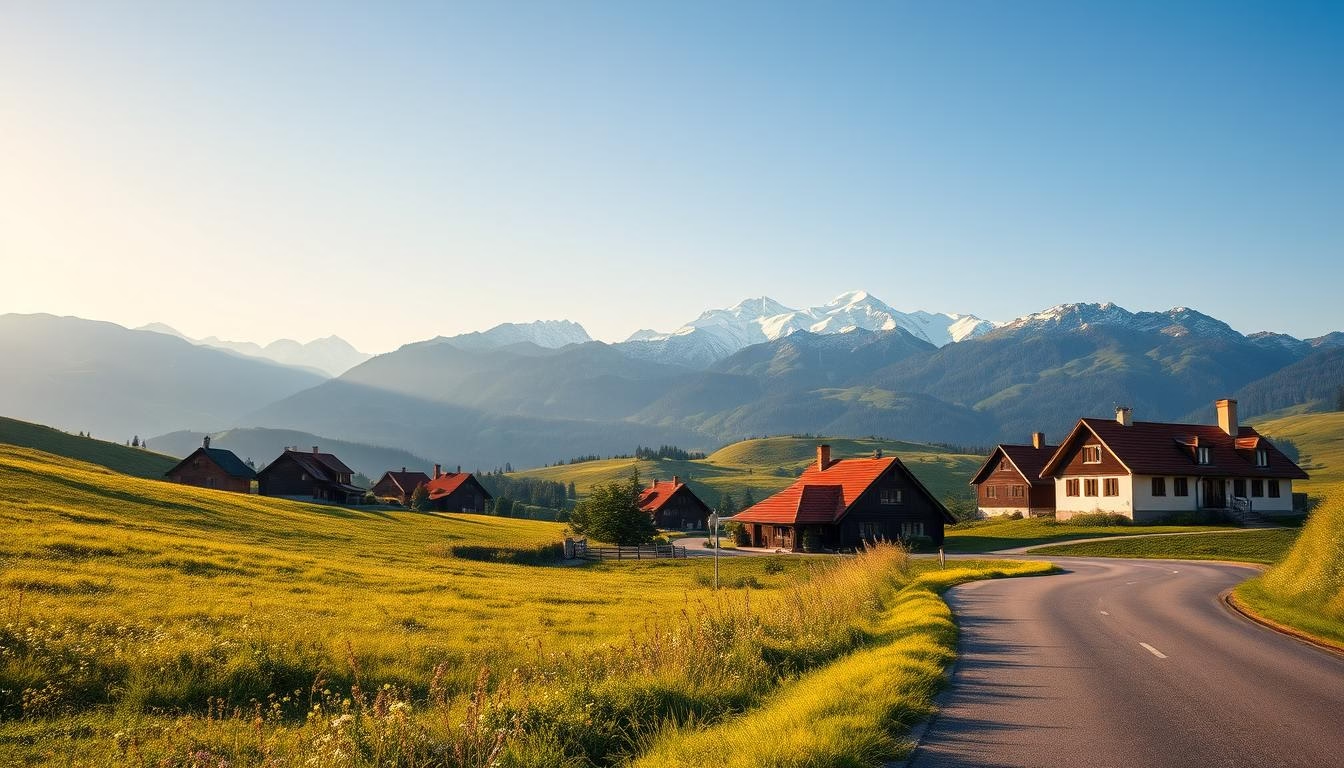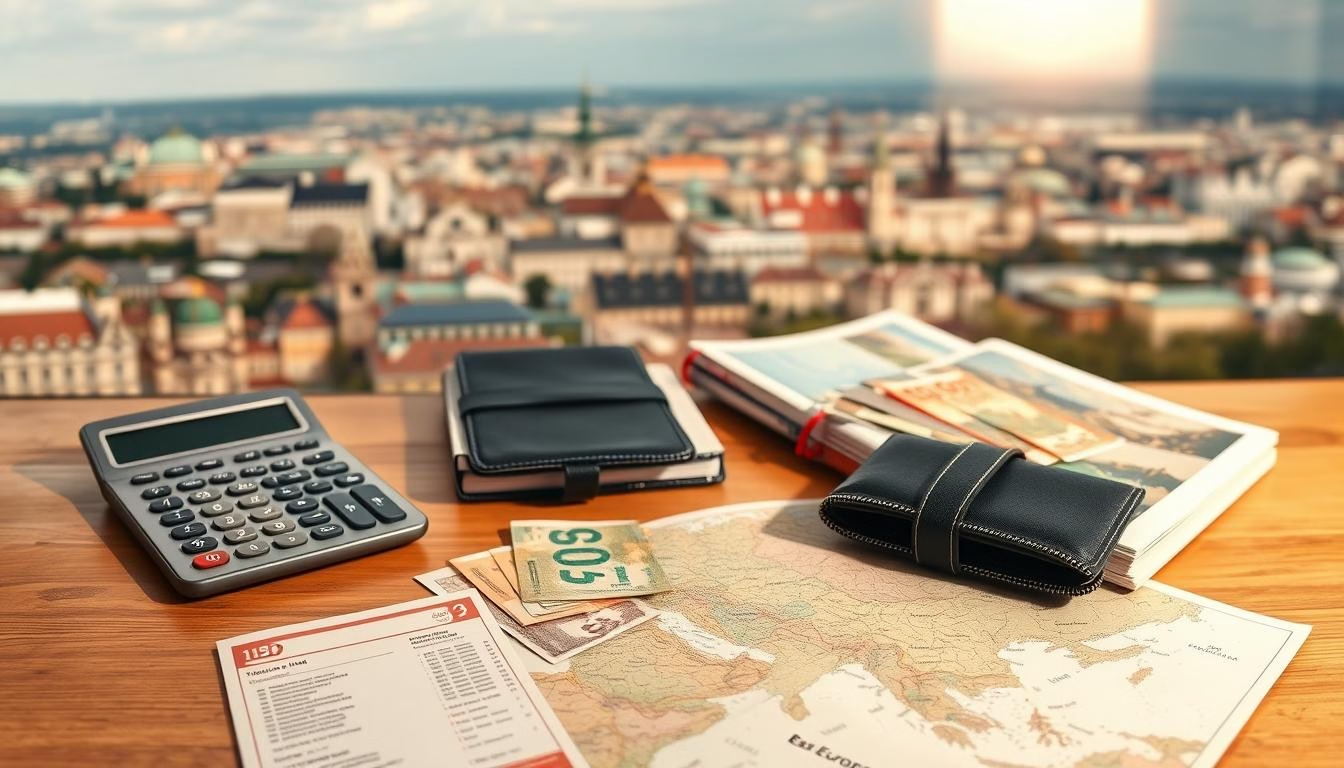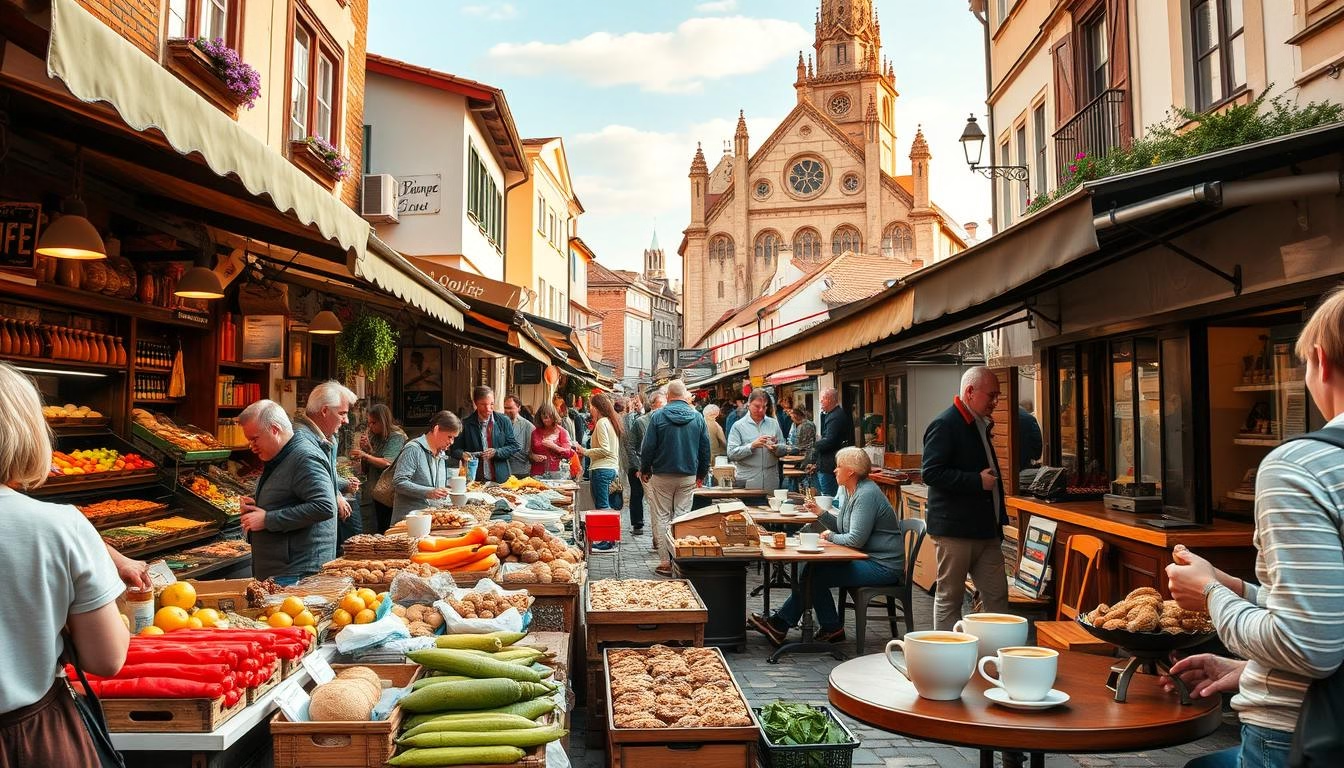What if you could go on a Budget Road Trip in Europe and uncover hidden gems without emptying your wallet? Eastern Europe offers unspoiled landscapes, deep-rooted history, and affordable adventures—all waiting just beyond the typical tourist path.
Travelers often overlook this region’s affordability. Yet it delivers lower costs for accommodation, food, and attractions compared to its western neighbors. You’ll find medieval towns with cobblestone streets, thermal spas tucked in mountain ranges, and lively festivals—all accessible on a modest spending plan.
This guide reveals practical strategies for crafting an unforgettable journey. Learn to navigate border crossings smoothly, discover underrated stops between major cities, and tap into local hospitality networks. You’ll even find out how to sample authentic cuisine at prices that’ll make you double-check the menu.
Curious about balancing spontaneity with careful planning? We’ll show you how to prioritize experiences that matter most—whether it’s hiking Carpathian trails or exploring Budapest’s ruin bars. The secret lies in smart resource allocation, not endless spreadsheets.
Understanding the Budget Road Trip in Europe Concept
Unlocking Europe’s hidden gems on a shoestring requires blending strategy with spontaneity. The core idea? Maximizing experiences while minimizing expenses through clever choices. Think thermal baths in Hungary, Balkan coastlines, or Polish castle trails—all accessible without luxury spending.
Smart resource allocation makes this possible. Services like Imoova offer campervan relocations for €1 per day, letting you drive vehicles needing repositioning. Companies like Indie Campers and Roadsurfer use these deals to move their fleet, giving travelers wheels for less than a coffee.
Consider these money-stretching tactics:
| Strategy | How It Works | Savings Potential |
|---|---|---|
| Vehicle Relocations | Drive rentals to new locations | 90% off standard rates |
| Off-Season Timing | Travel April-May or September | 40% lower accommodation costs |
| Nature Camping | Use free rural sites | €0 nightly fees |
| Local Markets | Self-cater meals | €5-10/day per person |
Balance is key. Splurge on a guided Danube River cruise one day, then picnic with market cheeses the next. This approach keeps your adventure diverse without draining funds. Free walking tours in cities like Kraków or Ljubljana deliver rich history lessons at zero cost.
Remember: flexibility unlocks the best deals. A last-minute campsite near Transylvanian forests often beats pre-booked hotels. With the right mix of planning and improvisation, you’ll craft memories that outshine any five-star resort stay.
Planning Your Route and Schedule
Crafting the perfect journey through Eastern Europe’s mosaic of cultures starts with smart geography hacks. Focus on clusters of attractions to reduce windshield hours while maximizing discovery potential.
Mapping Out Scenic Routes and Must-See Destinations
Group destinations within 2-3 hour drives to balance driving and exploring. The Transfăgărășan Highway in Romania delivers castles, lakes, and hiking trails in one swoop. Slovenia’s Julian Alps route packs glacial lakes, medieval towns, and cheese farms into 100 miles.
Use apps like Maps.me to find hidden waterfalls or local cafes between cities. This turns transit time into bonus adventures without extra fuel costs.
Time Management and Flexibility Considerations
Border crossings between countries like Hungary and Croatia can add 45+ minutes. Always check visa requirements and toll systems in advance. Build two buffer days weekly for unexpected finds—like a Bulgarian rose festival or Slovakian cave tour.
Seasonal shifts matter. Mountain passes in Montenegro close by November, while Baltic beaches shine in June. Align your schedule with regional calendars to avoid missed opportunities.
Budgeting Essentials for Your Eastern Europe Adventure
Mastering your spending plan transforms Eastern Europe’s possibilities into reality. Recent data shows travelers averaged £39 daily over 7 months, proving immersive experiences don’t require luxury spending. Let’s break down where your money goes and how to stretch it further.
Estimating Daily Travel Expenses
Costs swing wildly between countries. Albania’s guesthouses might charge €15/night, while Croatia’s coastal towns demand triple that. Fuel remains a top expense—£2,406 covered 12,000 miles in one case. Use this breakdown as a starting point:
| Category | Average Daily Cost | Money-Saving Tip |
|---|---|---|
| Accommodation | €10-40 | Camp or use rural guesthouses |
| Fuel | €20-35 | Share rides via BlaBlaCar |
| Food | €8-25 | Shop at Lidl/Aldi weekly |
| Activities | €0-15 | Prioritize free hiking trails |
Balancing Accommodation, Fuel, and Food Costs
Spend more nights in North Macedonia to offset pricier stops in Slovenia. Cooking meals slashes food budgets by 50% compared to restaurants. One couple spent just £62 weekly at supermarkets—that’s €4.40 per person daily!
Always keep a 20% buffer for surprises. A sudden campervan repair or spontaneous folk festival shouldn’t derail your plans. Track expenses daily using apps like Trail Wallet to stay on target without sacrificing spontaneity.
Choosing the Right Campervan: Renting vs. Personal Vehicle
Selecting the right transport sets the tone for your entire journey. While campervans promise freedom, personal vehicles offer familiarity – each option shapes your experience differently.
When Relocations Deliver Unbeatable Value
Need wheels for less than a latte? Services like Imoova partner with Indie Campers and Roadsurfer to offer €1/day relocations. You’ll drive vehicles needing repositioning between hubs like Barcelona, Athens, or Oslo. The catch? Routes and timelines get decided by rental companies – perfect for flexible travelers.
| Factor | Campervan Relocation | Personal Vehicle | Key Notes |
|---|---|---|---|
| Daily Cost | €1-5 | Ownership fees only | Relocations include insurance |
| Route Control | Limited | Full customization | Relocations follow fixed paths |
| Comfort Level | Sleeping quarters | Known ergonomics | Personal cars feel “like home” |
| Fuel Efficiency | 8-12 MPG | 25-40 MPG | Small cars save on gas |
Why Your Own Ride Might Shine
Driving your trusted car means no learning curves on mountain passes. You’ll skip rental paperwork and enjoy better mileage. Just ensure your insurance covers cross-border travel and invest in breakdown coverage.
One couple saved €800 using their hatchback instead of a camper. They cooked meals in parking lots and converted the backseat into a bed. “We knew every rattle and quirk,” they shared, “which helped on Bosnia’s winding roads.”
Ultimately, your choice depends on what you value most: rock-bottom prices or total control. Either way, Eastern Europe’s landscapes await.
Affordable Travel Options Across Europe
Exploring Eastern Europe doesn’t require deep pockets when you know the right travel hacks. From rail passes to tip-based tours, smart transit choices stretch your funds while delivering authentic experiences.
Utilizing Interrailing and Bus Networks
Interrailing remains a top choice for multi-country adventures. Passes start at €190, granting access to 33 nations’ rail systems. Non-drivers love the flexibility—wake up in Prague, lunch in Bratislava, and sleep in Budapest without touching a steering wheel.
For tighter budgets, companies like FlixBus offer €5 fares between cities when booked early. While journeys take longer than flights, you’ll save enough for three extra museum tickets. Consider these options:
- Overnight buses: Save on accommodation while moving between destinations
- Multi-ride passes: Get 20% discounts on frequent routes
- Student discounts: Flash an ID card for 15% off select carriers
Exploring Public Transport and Free Walking Tours
Once you arrive, cities like Warsaw and Belgrade make navigation easy. Their 72-hour transit passes (€10-15) cover trams, buses, and metro lines. Many systems now accept contactless payments—your credit card becomes your ticket with automatic daily spending caps.
Free walking tours transform sightseeing into interactive lessons. Guides from Sandman’s Tours share castle secrets and café recommendations, working solely for tips. Budget €5-10 per person for these 2-hour deep dives into local history.
Three pro tips for urban explorers:
- Download city-specific transit apps for real-time updates
- Check attraction websites for “free admission” hours
- Ask guides about hidden viewpoints away from crowds
Saving Money on Food and Activities
Feasting on flavors and discovering hidden gems doesn’t require emptying your wallet. Smart travelers know that supermarkets and scenic picnics unlock authentic experiences while keeping costs low. Imagine biting into fresh Bulgarian peppers at a mountain overlook or sipping Croatian wine as the Adriatic glitters below—these moments cost pennies but create priceless memories.
Fuel Your Journey Through Local Markets
Self-catering slashes food costs by up to 60%. A couple can eat well on £62 weekly by shopping at Lidl or Aldi. Try Poland’s oscypek cheese from a Zakopane market stall or grab Hungary’s paprika-spiced sausages for grill nights. Farmers’ markets in Transylvania often let you taste-test before buying—chatting with vendors might score free samples!
Experience More Without Spending More
Eastern Europe’s best activities often come free. Hike Transfăgărășan Highway’s trails, swim at Split’s Bacvice Beach, or wander Tallinn’s medieval walls. Cities like Kraków offer free museum days—check websites for schedules. Don’t miss:
- Sunset picnics at Latvia’s Jurmala beaches
- Guided tours of Romania’s painted monasteries (donation-based)
- Open-air concerts in Prague’s parks during summer
Religious sites provide cultural immersion and cool respites. Italy’s cathedrals showcase art for free, while Lithuania’s Hill of Crosses offers haunting beauty at no cost. Ask locals about village festivals—you might stumble upon folk dancing or craft workshops without spending a euro.
Cost Breakdown: Fuel, Tolls, and Other Expenses
Managing expenses effectively separates stressful journeys from smooth adventures. While fuel and tolls dominate spreadsheets, hidden fees and regional quirks demand equal attention. Savvy travelers track four key areas: refueling patterns, border policies, maintenance needs, and local payment preferences.
Fuel Efficiency and Smart Refueling Strategies
Prices swing wildly between nations. Fill your tank in Luxembourg (€1.65/liter) before entering pricier Switzerland (€2.10). Montenegro’s coastal stations often undercut Croatia by 15%, while North Macedonia offers some of the Balkans’ lowest rates. Use apps like Fuelio to locate deals in real time.
Consider this regional price comparison:
| Country | Avg Diesel Price | Best Time to Buy |
|---|---|---|
| Hungary | €1.72 | Weekday mornings |
| Romania | €1.68 | Before holiday weekends |
| Slovakia | €1.75 | Chain stations near borders |
Toll systems vary just as dramatically. Germany’s autobahns cost nothing, but Austria requires a €11.50 vignette sticker for 10 days. The Mont Blanc Tunnel’s £64 fee stings—opt for free Alpine passes like Stelvio if timing allows.
Three often-overlooked costs:
- Border fees: €5-15 at crossings like Croatia-Bosnia
- Safety gear: Reflective vests (€8) required in Serbia
- Parking: City centers charge €3-10/hour; use suburban lots
Carry both cash and cards. Bulgaria’s rural stations prefer leva, while Estonia’s contactless systems work seamlessly. Track every expense with apps like RoadBudget to stay on course.
Family and Pet-Friendly Road Trip Considerations
Traveling with loved ones adds joy but requires smart adjustments. Whether you’re chasing waterfalls with kids or hiking trails with furry companions, balancing fun and practicality makes adventures memorable.
Keeping Young Explorers Engaged
Family-friendly campsites shine for multi-generational trips. Many offer holiday homes with kitchens and playgrounds—perfect for saving on meals and entertainment. A week at these spots often costs 40% less than hotels while providing space for board games and sunset barbecues.
Four-Legged Travel Companions
Bringing pets adds paperwork and planning. Recent travelers spent €280 on dog passports, shots, and supplies for a 2-month trip. Ferries often charge extra for kennel reservations—factor this into transportation budgets.
| Expense | Cost Range | Tips |
|---|---|---|
| Pet-Friendly Stays | €10-25/night | Book early in summer |
| Veterinary Docs | €120-200 | Start 3 months ahead |
| Ferry Upgrades | €15-50 | Compare cabin vs kennel fees |
Peak season brings higher prices but longer daylight for exploring. Pack reusable water bottles and trail snacks to avoid costly stops. With thoughtful prep, your crew can enjoy castle tours and coastal drives without breaking the bank.
Seasonal Tips and Timing Your Journey
Smart timing transforms good adventures into great ones. While summer draws crowds to popular spots, quieter months reveal Eastern Europe’s hidden rhythms. You’ll find empty trails at sunrise and locals with time to share stories over homemade rakija.
Benefits of Off-Peak Travel
September’s golden light bathes medieval towns without the July heat or tourist queues. Campervan relocations surge in spring, offering wheels for €1/day as companies reposition fleets. Accommodation prices drop 30-40%, letting you upgrade to castle-view rooms or thermal spa stays.
Shoulder seasons also mean easier parking and shorter museum lines. Imagine having Romania’s Corvin Castle courtyard or Latvia’s Rundāle Palace gardens all to yourself. Local festivals bloom during these months too—harvest celebrations in Hungary or folk music gatherings in Slovakia.
Weather and Safety Considerations
Mountain passes like Transfăgărășan Highway close by November, while coastal roads in Croatia stay accessible year-round. Always check regional forecasts—sudden storms can flood Balkan routes in spring. Pack layers for crisp mornings that melt into warm afternoons.
Prioritize tires with solid tread for winding roads near Slovenia’s Julian Alps. Keep an emergency kit with blankets, snacks, and a portable charger. Apps like Windy provide real-time weather updates, helping you avoid risky drives during heavy rains or fog.
With thoughtful timing, you’ll experience vibrant cultures and landscapes while dodging peak-season hassles. The sweet spot? Chasing autumn’s amber hues through Czech forests or catching spring wildflowers along Bulgaria’s Black Sea coast.



